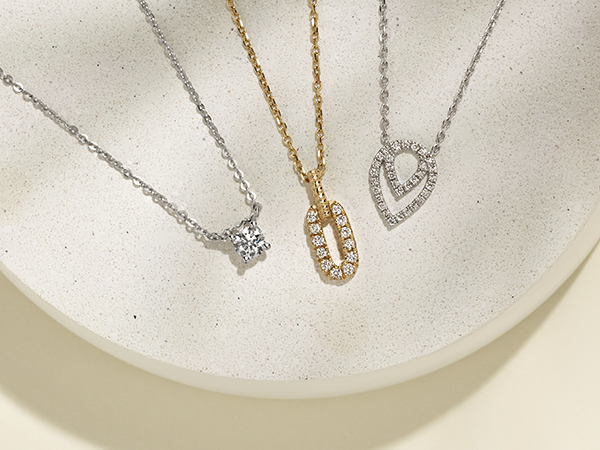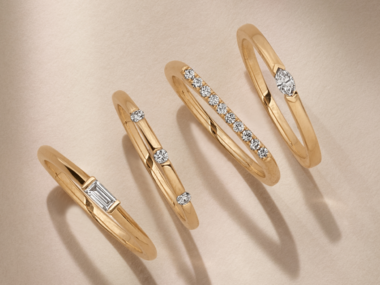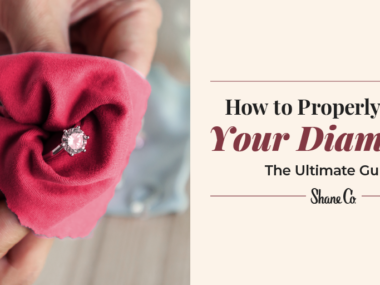Congratulations, April babies: You have the one-of-a-kind diamond as your birthstone! As the most talked-about and popular gem, diamonds have a rich history that highlights their rarity, beauty and unbeatable sparkle.

How are diamonds made?
You’ve probably heard somewhere that diamonds are made of carbon, the same life-giving element that can be found in the tip of your pencil, that lump of coal in the fireplace, and even in you — 18.5% of you, in fact. But what causes this common element to transform into the stunning stone that takes center stage in most engagement rings?
It all starts with carbon-bearing materials deep underneath the Earth. There are only two places where these gems are able to form: the lithospheric mantle, found below stable continental plates, and the site of a previous meteorite strike. Here, the carbon is exposed to high pressure while maintaining relatively low temperatures, where it begins its process of transforming into a raw diamond. Diamond-bearing rock is then carried from the mantle to the earth’s surface by deep-origin volcanic eruptions. The magma from these eruptions comes from the same layer of the earth where diamonds are formed, so the rock is able to travel through volcanic pipes, spreading it all over the world. That’s why we find deposits in South Africa, India, Brazil and even some areas of the U.S. Because of the long and arduous process that they go through, diamonds are the strongest gem we know of. They get their name from the Greek word “adamas,” which translates to “unconquerable,” a reference to the stone’s unparalleled hardness.
Did you know?
If you’ve ever stared at a diamond and thought it looked other-worldly, you might not be too far off — many of the ones on our planet today actually originated in space. There’s even a specific type called “carbonado,” found in South America and Africa, thought to be deposited via an ancient asteroid impact about 3 billion years ago. While some of these stones came to us embedded in meteorites, diamonds are also formed in the craters created when an asteroid impacts the earth.
The history of diamonds
Some historians estimate that the first diamond trading began as early as 4 B.C. Because they were one of the only materials that could be used to engrave metal, they were prized for this strength and their ability to reflect light. Some ancient civilizations even believed that the stones were lightning made real on Earth, and many believed that the stone had great healing powers. These powers included the ability to heal brain disease, alleviate pituitary gland disorders, draw toxins from the blood and more.
Diamonds were first popularized in India, when the Moghuls and Imperial Colony mined them from deposits along three major rivers. By the 1400s, the gem was becoming fashionable among Europe’s elite, particularly because they were so rare at the time. In the early 1700s, India’s diamond mines were being depleted and Brazil emerged as a new and important source. Diamonds were discovered in the pans of gold miners sifting through local rivers, and Brazil dominated the market for over 150 years afterward.
The late 1800s marked a shift in the industry because of two major events. The first was that South African deposits were discovered and began to be mined, and the second was the establishment of De Beers, an international corporation specializing in diamond exploration and mining, in 1888. By 1900, De Beers controlled an estimated 90% of the world’s production of rough diamonds.
New mines continued to be discovered throughout the late 1900s and early 2000s, including mines in Australia, Canada and the former Soviet Union. De Beers began to greatly reduce its role as the custodian of supply, with diamonds flowing through multiple channels, rather than a single-channel path from the well-known supplier.
Today, our diamond deposits are being slowly depleted. The finite nature of this gem is one of the reasons why they are so highly prized as the rare and beautiful stone they are. In fact, less than 20% of diamonds pulled from the earth today are considered gem quality, and even fewer are considered “investment diamonds” (a.k.a. the ones you’ll find in most engagement rings). You need 250 tons of ore to produce a 1.00-carat, gem-quality stone. Diamonds that don’t qualify as gem quality are used in industrial applications.
Did you know?
In 2007, the Harvard-Smithsonian Center for Astrophysics announced the discovery of a 10 billion-trillion-trillion-carat diamond in the sky, which they named “Lucy” after the Beatles song “Lucy in the Sky with Diamonds.” This white dwarf star is essentially a giant chunk of crystallized carbon that weighs a whopping 5 million-trillion-trillion pounds. However, this enormous rock is located 50 light years from Earth, so don’t get your hopes up about claiming it as your own just yet.
Famous diamonds
The Blue Hope: Sometimes referred to as the Hope Diamond, this gem is known less for its appearance than its turbulent history and legendary “curse.” It was named after its purchaser, Henry Thomas Hope, and was part of a larger stone brought to Europe from India in the 1600s. It was stolen during the French Revolution and sold to Hope in 1830, but after inheriting the gem, Hope’s son lost his entire family fortune, giving it a reputation for carrying bad luck to its owners. This reputation stuck when Mrs. Edward McLean acquired the stone and subsequently lost her fortune, experienced her only child dying from an accident, then took her own life in the mid-1900s. The Hope Diamond was purchased by Harry Winston in 1949 but was eventually put on display at the Smithsonian Institute in Washington, to save any future owners from the bad luck it was believed to carry.
The Great Star of Africa: This stone is the largest cut diamond in the world, weighing in at 530.20 carats. The Great Star of Africa is a pear cut with 74 facets and is currently set in the royal scepter, held with the other Crown Jewels in the Tower of London. It was cut from a 3106-carat gem called the Cullinan, which is the largest diamond ever found to date. Discovered at a mine in Transvaal, South Africa, the Cullinan was cut into nine major diamonds and 96 smaller diamonds, though it’s believed that it may have only been half of a much larger stone.
The Orloff: Another famous diamond is the Orloff, which is believed to have been once used as the eye of a Hindu god at a temple in India. In the 1700s, it was stolen by a French deserter who sold it to an English captain for only 2,000 pounds. When it arrived in Amsterdam, Russian count Grigori Orloff purchased it for 90,000 pounds, hoping to bring it back to Russia to impress his lover, Catherine the Great. Legend has it that the stone was hidden in a priest’s tomb when Napoleon’s army advanced on Moscow in 1812. The stone now sits in the Diamond Treasury of Russia in Moscow.
Did you know?
Text: There are an endless number of interesting facts about the beautiful April birthstone. If you’re curious, here are a few more things you probably didn’t know about diamonds:
- Around 1.5 million diamond nanoparticles can be found in a candle’s flame, which may be why its light is often compared to the sparkle of this rare gem. We knew there was a reason why candlelit dinners are so romantic!
- The first diamond in South Africa, called the Eureka, was discovered by a 15-year-old boy named Erasmus Stephanus. At first glance, he thought the 21.24-carat raw stone was nothing but a simple pebble.
- Not all diamonds are colorless. Natural colored diamonds are extremely rare but can be found in shades of red, blue, pink, yellow, brown, black and even green.
- A diamond loses up to 50% of its weight during the cutting and polishing operation. This process is essential to producing the incredible sparkle and unique shapes we find in popular diamond cuts.
- Despite being mined all around the world, almost 80% of diamonds are sold in New York City.
Shane Co.: the diamond experts

If you want to see all of Shane Co.’s diamond jewelry to find the perfect gift for your April sweetheart (or you just want to buy something for yourself), you can browse our entire collection of rings, bracelets, necklaces and more diamond jewelry. Shane Co.’s jewelers buy diamonds directly from the cutters and hand-pick each stone for its individual beauty and sparkle. With a Free Lifetime Warranty included on most of our jewelry, even the center stones of diamond engagement rings, it’s easy to embrace the meaningful shine of this rare gem. Looking for something more specific? Some of our more popular trends include:
Stud earrings: Our diamond studs are hand-matched by experienced jewelers for the perfect everyday or special occasion pair. Choose from round or princess cut stones and high-quality 14k yellow or white gold to create your new favorite piece.
Custom pendants: Shane Co. has dozens of pendant necklace designs just waiting to be completed with the sparkling gem of your choice. Explore romantic styles like this Round Diamond Double Halo Pendant, or choose a unique Diamond Intertwined Circle Necklace for a stylish look.
Loose diamonds: With hundreds of ethically and directly sourced stones to choose from, we’re proud to offer the prettiest loose gems in every GIA grade. Find the right shape for your style and budget with our wide selection of one-of-a-kind diamonds.
Diamond rings: Shop hundreds of diamond rings for a gift that never fails to impress. This Diamond Ring in Rose Gold will definitely set her heart aflutter, while timeless white gold is sure to please. With stackable bands, contemporary designs and intricate details, it’s easy to find a ring to fall in love with at Shane Co.


